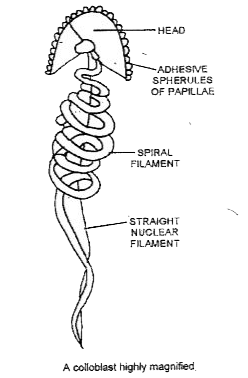Phylum - Ctenophora || Phylum - Platyhelminthes
Video Solution
Text Solution
History. The first definite description of ctenophores was given by Martens in 1971. Linnaeus and Cuvier placed some ctenophores under Zoophyta, class Acalephes. Eschscholtz (1829-1833) arranged the pelagic coelenterates under three orders---Ctenophorae, Discophorae and Siphonophorae. In 1847, Leuckart separated from echinoderms the phylum Coelenterata which also included sponges and ctenophores. It was Hatschek (1839) who put all the ctenophores under a distinct phylum.
Derivation of name. The name Ctenophora means "comb-bearers.. It is derived from two Greek words, ktenas (comb) and phoras (bearing), and refers to locomotory comb-like plates on the body. Definition. The Ctenophora are marine, pelagic or free, solitary, and biradially symmetrical radiate, with transparent gelatinous bodies, not reducible to either polyp or medusa type, without nematocysts but having special lasso. cells, and with characteristic eight locomotory, meridional, comb like ciliary plates. Distinctive characters.
1. Exclusively marine, solitary, free-swimming or pelagic, without colony-formation, very active carnivorous and often phosphorescent.
2. Body soft, delicate, transparent and gelatinous, like coelenterate jelly-fishes, and without segmentation.
3. Form typically spherical, pear-shaped or cylindrical, flat in some.
4. Symmetry definitely biradial (radial + bilateral) along an oral-aboral axis.
5. Skeletal, excretory, circulatory and respiratory systems are absent.
6. Most characteristic feature is the presence on the surface of eight meridional rows or comb like ciliary plates, forming locomotor organs, hence the common name comb-jellies or sea-walnuts.
7. Generally a pair of long, solid and retractile tentacles present, projecting from blind pouches in opposite sides of the body. .
8. Nematocysts are absent but the tentacles bear special adhesive cells, called lasso cells or colloblasts, which help in food-capture.
9. Body acoelomate but triploblastic, with well-developed mesoderm including muscles and connective cells.
10. The mouth, lying at one end leads into a large ectodermal stomodaeum connected with a series of endodermal gastrovascular canals. ·
11. Nervous system is diffused type. The aboral end bears a sensory organ of equilibrium, the statocyst.
12. All are hermophroditic. Testes and ovaries formed side by side from endoderm of digestive canals.
13. Development usually includes a complex metamorphosis with a characteristic cydipped larva, but there is no asexual reproduction and alternation of generations.
14. Regeneration and paedogenesis are common.
 Economic Importance. The ctenophores are of no direct conomic importance to man, except that they may consume large number of oyster larvae at spawning time. Like jelly-fish, the ctenophores are eaten by many marine animals. They serve as food for even large animals as whales.
Economic Importance. The ctenophores are of no direct conomic importance to man, except that they may consume large number of oyster larvae at spawning time. Like jelly-fish, the ctenophores are eaten by many marine animals. They serve as food for even large animals as whales.
Was this answer helpful?974
Updated on:21/07/2023
Similar Questions
Phylum Ctenopora|Phylum Platyhelminthes
36:51View SolutionPhylum-Ctenophora
37:32View SolutionPhylum Ctenophora
39:45View SolutionPhylum Porifera#!#Coelentrata#!#Ctenophora
01:34:11View SolutionDescribe Phylum-Ctenophora.
02:07View SolutionWhat are the characteristics of phylum Ctenophora.
02:18View SolutionClassification Of Animals|Phylum - Porifera|Phylum - Coelenterata|Platyhelminthes
32:51View Solution
